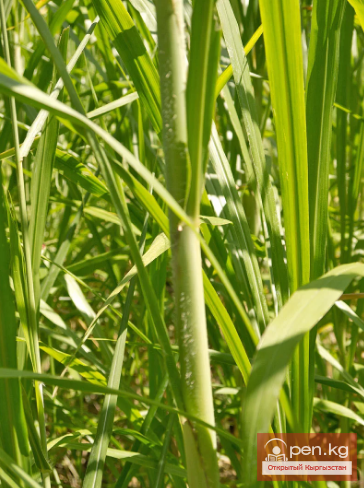
SUGAR-BEARING PLANTS
In Kyrgyzstan, there are no wild sugar-bearing plants from which sugar is directly extracted. However, the natural flora of the republic includes species that contain sugar, albeit in small amounts.
Sugar beet. Among cultivated plants, it is the most important sugar-bearing plant. It has been cultivated for a long time, primarily in the Chui Valley, specifically for sugar production. Previously, it contained 23% sugar and had a high yield. The Hero of Socialist Labor Zuurakan Kainazarova and others obtained over 1000 centners of beets per hectare. However, in recent years, the sugar content of sugar beet has sharply decreased to 10%, and its yield has also fallen dramatically. Currently, it yields only about 250 centners per hectare. Therefore, sugar beet has recently been removed from planned sowings as a sugar-bearing crop.
There are few wild sugar-bearing plants in Kyrgyzstan.
Only certain species contain sugar. These include: wild sugarcane, licorice, and camel thorn.

Sugarcane. It grows along riverbanks and in flood meadows, forming dense thickets. The main area of its distribution is the Fergana Valley. It reproduces by seeds and rhizomes. This perennial grass reaches a height of 1-2 meters and has a dense silver flower panicle.
It blooms in May and bears fruit in July. The stems contain 2-4% sugar. It is believed that wild sugarcane is the ancestor of cultivated sugarcane. It produces a lot of green mass suitable for silage. In India, ropes and coarse fabrics are made from the leaf sheaths of wild sugarcane.
In Kyrgyzstan, it is hardly used. It is occasionally grown in gardens as an ornamental plant, and natural young thickets are used as fodder for livestock.
Licorice

Smooth licorice. It is commonly known as licorice root, as it contains a sweet substance—glycyrrhizin. It is used in the food industry for making candies, kvass, and halva.
Licorice grows in the Chui Valley, in the basin of Lake Issyk-Kul, and in other regions, especially on fallow lands, in river valleys, and along lake shores. It thrives on slightly saline soils, where groundwater lies at a shallow depth. Currently, it is not fully utilized. Many of its areas remain untouched. This valuable sugar-bearing plant should be used more widely in the food industry and medicine.
Camel thorn or yantak. This perennial plant is known for its roots, which can reach depths of up to 18 meters; therefore, it remains green even in hot summers. However, camel thorn is also interesting because sugar forms on its stems and leaves. Yantak sugar is used in medicine and for making confectionery (candies, jams, cookies). However, extracting this sugar is still costly.
Among other sugar-bearing plants in Kyrgyzstan, it is worth noting capers and ferula foetida. However, these plants contain little sugar and are therefore unpromising for sugar extraction.
Overall, Kyrgyzstan is poor in sugar-bearing plants. A small amount of sugar is found in the fruits of cultivated plants such as watermelon, melon, and pumpkin. There is even sugar in cotton, but sugar is not extracted from these plants under the conditions of the republic.

